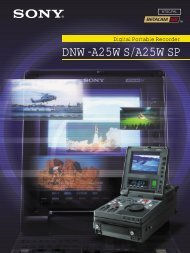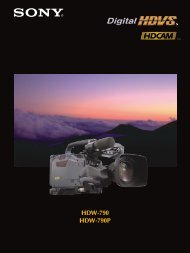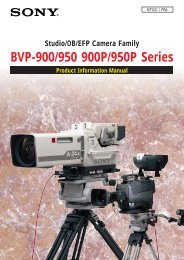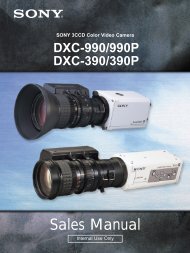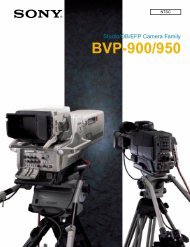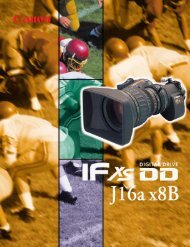1200 Series Professional VHF Wireless Systems - Audio-Technica
1200 Series Professional VHF Wireless Systems - Audio-Technica
1200 Series Professional VHF Wireless Systems - Audio-Technica
Create successful ePaper yourself
Turn your PDF publications into a flip-book with our unique Google optimized e-Paper software.
(Cont. from pg. 2)Attach the antennas to the antenna input jacks. The antennasare normally positioned in the shape of a “V” (45° fromvertical) for best reception.Do not try to move the antenna rod after the connectorshell has been tightened down. Always loosen theconnector shell completely before repositioning the rod.If there is not sufficient space above the receiver and/or if thereceiver is installed in a metal cabinet, the antennas can bemounted in the threaded holes in the back of the connectorsso the antennas will stick straight out from the back of thereceiver. Use one set of threaded holes or the other; do notattempt to bend the antenna rods. The optional accessoryATW-RA1 rack-mount antenna kit brings antenna inputs to thefront of the receiver. When two receivers are mounted sideby-sidein single 19" rack space, one ATW-RA1 is required foreach receiver.Power ConnectionsConnect to a standard 120 volt 60 Hz AC power outlet. Ifthere is no AC power available, the back panel is equippedwith a jack for an external 12-18 volt DC source. The jacktakes a standard 2.5 mm I.D. coaxial DC power plug, centernegative. Power from the DC input jack is switched by thefront-panel Power switch.Transmitter SetupBattery Selection and InstallationAn alkaline 9-volt battery is recommended. Make certain thetransmitter power switch is Off before installing or changingbatteries.When inserting the battery, observe correct polarity asmarked inside the battery compartment. The transmitterhousings are designed to prevent incorrect installation of thebattery; do not force the battery in. Reversed batteries maycause damage to the transmitter.Handheld Transmitter Battery Installation1. While holding the middle of the microphone body normally,unscrew the battery cover (bottom 3" section) as shown inFigure G.2. Lift the white “battery keeper” arm and carefully insert afresh 9V alkaline battery, observing polarity markings(Fig. H).3. Replace the battery cover. Do not overtighten.Fig. GFig. HBattery Condition IndicatorAfter the battery is installed, turn the power on. The batterycondition indicator LED (Fig. I/J) should flash momentarily.If it does not, the battery is installed incorrectly or it is dead.If the indicator LED stays on (does not flash), the batteryvoltage is low and the battery should be replaced. If thishappens during use, replace the battery immediately toensure continued operation.UniPak Transmitter Battery Installation1. Slide off the battery cover as shown in Figure E.2. Insert a 9V battery, observing correct polarity as markedinside the battery compartment.3. Replace the battery cover. Set the cover in place on thetransmitter as shown in Figure F, so it rests fully on thecase, then slide it forward firmly until it clicks closed.Fig. IInputConnectorBatteryConditionIndicatorPower Switch(Off/Standby/On)Power Switch(Off/Standby/On)Fig. JBattery ConditionIndicatorFig. EUniPak Transmitter Input ConnectionConnect an audio input device (microphone or guitar cable) tothe audio input connector on the bottom of the transmitter. Anumber of <strong>Audio</strong>-<strong>Technica</strong> professional microphones and cablesare available separately, pre-terminated with a UniPak inputconnector (see “Optional System Accessories” on page 6).Fig. F4
System OperationTurn down the AF Level of the receiver as well as the mixer.Switch on the receiver. Do not switch on the transmitter yet.Receiver On…The power indicator will light up and one of the tuner operationindicator LEDs (A or B) will light, even though the transmitter isnot on. If any of the RF LEDs light up at this point, there may beRF interference in the area, or a nearby TV station is on thesame frequency. Check the frequency of the system against thechart on page 7 to ensure you have the proper frequency foryour area. The frequency is marked on the back panel of thereceiver.Transmitter On…When the transmitter is switched on and in normal operation,the receiver’s RF signal level indicators will light up from left toright. For optimum performance at least four, and preferably five,of the signal strength indicators should light up when the transmitteris switched on. The transmitters have a three-positionpower switch. When the switch is set to “Standby,” the transmitterproduces RF with no audio signal. When the switch is“On,” the transmitter produces both RF and audio.For INSTRUMENT: Next, while again playing the instrumentat typically-loud levels, adjust the receiver’s AF Level control sothe highest signal level causes no input overload in the instrumentamplifier, and yet permits the amplifier’s input levelcontrols to operate in their “normal” range (not set too highor too low).NOTE: With some instrument amplifiers, the receiver’s AF Levelcontrol may need to be adjusted to between “0” and “+6” tobetter drive the amplifier.CAUTION! The small trimmer controls are delicate; use only asmall screwdriver or alignment tool with a maximum 3 /32"-wideblade. Do not force the trimmers beyond their normal 210°range of rotation.MicrophoneTrimmer (M)GuitarTrimmer (G)Setting LevelsCorrect adjustment of transmitter audio input, receiver audio output,and mixer/amplifier input and output levels is important foroptimum system performance.• ATW-T35 UniPak TransmitterTrimmer adjustments in the UniPak transmitter (Fig. K) willenable you to use microphones or instruments with differentoutput levels.1. Set both the transmitter Mic Level (M) and Guitar Level (G)controls to their full counter-clockwise position (minimum). (Thelevel control not being used should be set to minimum.)2. Set the receiver’s AF Level control to “0.”3. Plug the mic or instrument into the transmitter and power upthe system.4. For MIC: Make an initial adjustment of the mixer’s levelcontrols that will allow audio through the system as you increasethe transmitter’s Mic Level.For INSTRUMENT: Make an initial adjustment of the instrumentamplifier input level control that will allow audio throughthe system as you increase the transmitter’s Guitar Level.5. For MIC: While speaking/singing into the microphone at typically-loudlevels, turn up the transmitter’s Mic Level (M) controluntil the maximum audio output of the mic lights about three orfour green LED segments on the receiver’s AF Level indicator.For INSTRUMENT: While playing the instrument at typicallyloudlevels, turn up the transmitter’s Guitar Level (G) control untilthe maximum audio output of the instrument lights about threeor four green LED segments on the receiver’s AF Level indicator.NOTE: Do not set the transmitter level too high (as indicatedby lighting of the red LED) – doing so will cause the system tooverload and distort.6. For MIC: Next, while again speaking/singing into themicrophone at typically-loud levels, adjust the mixer’s input trimcontrol so the highest sound pressure level going into the microphonecauses no input overload in the mixer, and yet permitsthe mixer’s channel and output level controls to operate in their“normal” range (not set too high or too low).NOTE: With the receiver’s AF Level control set at “0,” thebalanced output voltage will be similar to that of a typical wiredmicrophone. However, the AF Level control may be adjustedto accommodate some microphone inputs – for example, thosewith limited-range or no input trim controls.Fig. K• ATW-T36HE and ATW-T37C Handheld TransmittersThe <strong>1200</strong> <strong>Series</strong> handheld transmitters have factory pre-setaudio input levels.1. Set the receiver’s AF Level control to “0.”2. Turn the transmitter on and power up the system.3. Turn down the mixer’s input trim control (if provided) onthe selected channel; make an initial adjustment of the mixerchannel and output level controls that will allow audio throughthe system.4. While speaking/singing into the microphone at typically-loudlevels, adjust the mixer’s input trim control so the highest soundpressure level going into the microphone causes no input overloadin the mixer, and yet permits the mixer’s level controls tooperate in their “normal” range (not set too high or too low).NOTE: With the receiver’s AF Level set at “0,” its balanced outputvoltage will be similar to that of a typical wired microphone.However, the AF Level may need to be adjusted to accommodatesome microphone inputs.Receiver SquelchThe squelch control on the back panel of the receiver is presetat the factory, but can be adjusted if you must use the systemin an area with considerable RF interference. If there isinterference in the receiver's audio, adjust the squelch control sothe system will receive the signal from your transmitter but will“squelch” or eliminate the unwanted background RF noise. Thisadjustment can cause a reduction in useable range of the wirelesstransmitter, so set the control to the lowest position thatreliably mutes the unwanted RF signals.5
Specifications †Optional System AccessoriesOVERALL SYSTEMOperating FrequencyFrequency Stability<strong>VHF</strong> high band, 169.505 to 213.800 MHz±0.005%, single-frequencycrystal-controlledFM±30 kHz, traveling frequencies ±15 kHz200' minimumModulation ModeMaximum Deviation RangeOperating RangeOperating Temperature Range 41° F (5° C) to 113° F (45° C)Frequency Response100 Hz to 15 kHzRECEIVERReceiving SystemImage RejectionSignal-to-noise RatioTotal Harmonic DistortionSensitivityIntermediate Frequency<strong>Audio</strong> OutputUnbalanced:Balanced:Output ConnectorsPower SupplyDimensionsWeightAccessories IncludedUNIPAK TRANSMITTERRF Power OutputSpurious EmissionsDynamic RangeInput ConnectionsBatteryCurrent ConsumptionBattery LifeDimensionsNet Weight (without battery)Dual independent receivers, automaticswitching diversity reception≥ 60 dB112 dB at 30 kHz deviation(IEC-weighted), maximum modulation75 kHz≤1% (10 kHz deviation @ 1 kHz)5.6 µV for 60 dB S/N (IEC-weighted)10.7 MHz100 mV (at 1 kHz, ±5 kHz deviation,10k ohm load)31.6 mV (at 1 kHz, ±5 kHz deviation,10k ohm load)Unbalanced: 1 /4" phone jackBalanced: XLRM-type120V AC 60 Hz; or 12-18V DC,350 mA, with external supply8.27" (210.0 mm) W x 1.93" (49.0 mm) Hx 8.86" (225.0 mm) D3.9 lbs (1.8 kgs)Two whip antennas, rack mount adapters50 mW MaxUnder federal regulations≥90 dBHigh impedance, low impedance, bias9V (NEDA type 1604) alkaline, not included35 mA typicalApproximately 10 hours (depending onbattery type and use pattern)2.40" (61.0 mm) W x 4.23" (107.4 mm) Hx 1.08" (27.5 mm) D2.8 oz (78 grams)HANDHELD TRANSMITTERRF Power Output50 mW MaxSpurious EmissionsUnder federal regulationsDynamic Range≥90 dBMicrophone ElementATW-T36HEA-T Hi-ENERGY ® dynamic hypercardioidATW-T37CA-T condenser hypercardioidBattery9V (NEDA type 1604) alkaline, not includedCurrent Consumption35 mA typicalBattery LifeApproximately 10 hours (depending onbattery type and use pattern)DimensionsATW-T36HE9.27" (235.5 mm) long,1.49" (37.9 mm) body dia.ATW-T37C9.38" (238.3 mm) long,1.46" (37.1 mm) body dia.Net Weight (without battery)ATW-T36HE8.6 oz (245 grams)ATW-T37C7.2 oz (204 grams)Accessory IncludedStand clamp† In the interest of standards development, A.T.U.S. offers full details on its test methodsto other industry professionals on request.MICROPHONES AND CABLESAT829cW AT829 miniature cardioid condenser microphone only,terminated for use with UniPak transmitter. Includesclothing clip and windscreen.MT830cW MT830R subminiature omnidirectional condensermicrophone only, terminated for use with UniPaktransmitter. Includes clothing clip and windscreen.MT830cW-TH ”Theater“ model, same as MT830cW except beige colormic and cable for concealment.AT831cW AT831b miniature cardioid condenser microphone only,terminated for use with UniPak transmitter. Includesclothing clip and windscreen.AT851cW AT851a surface-mount wide-range hemi-cardioidcondenser microphone only, terminated for use withUniPak transmitter.AT857AMLcW AT857AMLa 19" gooseneck cardioid microphone only,terminated for use with UniPak transmitter. Mounts to5/8"-27 thread. Includes windscreen.AT889cW Headworn noise-canceling condenser microphone only,terminated for use with UniPak transmitter. Includeswindscreen and cable clip.ATM35cW ATM35 high-intensity miniature cardioid condensermicrophone only, terminated for use with UniPaktransmitter. Includes AT8418 clip-on instrument mount.ATM73cW ATM73a headworn cardioid condenser microphone only,terminated for use with UniPak transmitter.ATM75cW ATM75 headworn cardioid condenser microphone only,terminated for use with UniPak transmitter. Includeswindscreens and cable clip.PRO 8HEcW PRO 8HEx headworn hypercardioid dynamic microphone,terminated for use with UniPak transmitter. Includeswindscreen and cable clip.PRO 35xcW PRO 35x cardioid condenser microphone only, terminatedfor use with the UniPak transmitter. Includes AT8418clip-on instrument mount.AT-GCW Hi-Z instrument/guitar cable with 1 /4" phone plug,terminated for use with UniPak transmitter.XLRW Connecting cable for UniPak transmitter with an XLRF-typeinput connector, for Lo-Z microphones with XLRM-typeoutput terminations.TRANSMITTER ACCESSORIESATW-VP10 Vinyl pouch with belt clip to hold UniPak transmitter.AT8114 Foam windscreen for handheld transmitter.AT8141 Water-resistant pouch for UniPak transmitter.AT8431 Stand clamp for handheld transmitter, 5 /8"-27 threads.AT8456 Stand clamp for handheld transmitter, 5 /8"-27 threads.INTERCHANGEABLE ELEMENTS (for use with ATW-T37C transmitter)AT853C-ELE Cardioid element.AT853H-ELE Hypercardioid element (included).AT853O-ELE Omnidirectional element.AT853SC-ELE Subcardioid element.RECEIVER ACCESSORIESAT8628 Mounting plate adapter allows rack-mounting twoATW-R12 receivers side-by-side in a single 19" rack space.ATW-A10 Pair of <strong>VHF</strong> ground-plane antennas with 5 /8"-27 thread formounting to microphone stands, etc. Takes RF cables withPL259 connectors, not included.ATW-D12a Active, unity-gain <strong>VHF</strong> antenna distribution systemprovides two “1-in, 4-out” amplifier/splitters; connects apair of antennas to as many as four diversity receivers.Includes two antennas, two input cable adapters and eightoutput cables.ATW-RA1 Rack-mount antenna kit brings antenna inputs to the frontof receiver for ease of setup, or when receiver is enclosedin a metal rack. Includes a pair of extendible antennas.NOTE: Two adapter kits are required when mountingtwo receivers side-by-side in a single 19" rack space.6
<strong>Wireless</strong> Operating FrequenciesFrequency SelectionEach transmitter/receiver system operates on a single factoryaligned,crystal-controlled frequency. Available frequencies areshown in the chart below.Operating frequency is specified by a two- or three-charactercode, such as “T2” or “11G,” in addition to the actualfrequency in MHz. The frequency of each transmitter appearson a label on the outside of the unit. The frequency of eachreceiver appears on a label on the back of the unit and thefrequency of each system appears on the outer carton. Forfuture reference, please record them in the space provided.Because most of these authorized frequencies are sharedwith TV broadcasting, frequency selection is largely dependentupon which TV broadcast channels are in operation wherethe wireless system is to be used.RF InterferenceIf you encounter receiving interference (from other than anoperating TV station), often it can be eliminated by adjustingthe receiver’s squelch control, as described on page 5.Please note that wireless frequencies are shared with otherradio services. According to Federal CommunicationsCommission regulations, “<strong>Wireless</strong> microphone operationsare unprotected from interference from other licensed operationswithin the band. If any interference is received by anyGovernment or non-Government operation, the wirelessmicrophone must cease operation…”If you need assistance with operation or frequency selection,please contact your dealer or the A-T professional division.Extensive wireless information also is available on the A-TWeb site at www.audio-technica.com.System Operating FrequenciesApplication Freq. Code Freq. (MHz)• Traveling frequencies: T2 169.505(Normally work anywhere in the U.S.A. and Canada, T3 170.245but as a result tend to be crowded.) T8 171.905• For use only where there is no TV Channel 7: 7G 175.8007I 176.200• For use only where there is no TV Channel 8: 8D 181.2008M 183.2008S 184.200• For use only where there is no TV Channel 9: 9F 187.6009Q 189.800• For use only where there is no TV Channel 10: 10C 193.00010J 194.40010W 196.800• For use only where there is no TV Channel 11: 11G 199.80011S 202.200• For use only where there is no TV Channel 12: 12L 207.00012S 208.20012V 208.600• For use only where there is no TV Channel 13: 13B 210.80013Q 213.800Multi-channel <strong>Systems</strong>Following are groupings of frequencies suggested for multi-channel wireless systems.• For use where TV channels 7, 9, 11 and/or 13 are operating: 8D-8M-8S-10C-10J-10W-12L-12S-12VTraveling frequencies T2, T3 and/or T8 may be used with any of the above frequencies except for: 8D,8M and 10C. Interference may result from the use of these frequency combinations.• For use where TV channels 8, 10 and/or 12 are operating: 7G-7I-9F-9Q-11G-11S-13Q or7G-7I-9F-11G-11S-13B-13QTraveling frequencies T2, T3 and/or T8 may be used with any of the above frequencies with nointerference problems.For future reference, please record your system information here (the serial numbers appear insidethe battery compartment of each transmitter, and on the bottom of each receiver):Operating FrequencyFreq. Code Frequency MHzReceiverModelSerial NumberTransmitterModelSerial Number7
Ten Tips To Obtain The Best Results1. Use only fresh alkaline batteries. Do not use“general purpose” (carbon-zinc) batteries.2. Position the receiver so that it has the fewest possibleobstructions between it and the normal location of thetransmitter. Line-of-sight is best.3. The transmitter and the receiver should be as closetogether as conveniently possible, but no closertogether than three feet.4. The receiver antennas should be in the open andaway from any metal. If mounted in a rack, have theunit on top, or angle antennas outward away from themetal rack.5. A receiver cannot receive signals from twotransmitters at the same time.6. The power switch on the transmitter has threepositions: “Off,” “Standby” and “On.” In the middle“Standby” position, the transmitter sends only RF tothe receiver; the audio source is turned off.7. For best operation, all the RF Level LEDs should belit (maximize RF input); but only the first two or threeAF Level LEDs should be lit (don’t overmodulate).8. If the AF Level control of the receiver is set too high,it may over-drive the input of the mixer or clip theoutput of the receiver, causing distortion. Conversely,if the receiver output is set too low, the overallsignal-to-noise ratio of the system may be reduced.Adjust the output level of the receiver so the highestsound pressure level going into the microphonecauses no input overload in the mixer, and yet permitsthe mixer level controls to operate in their “normal”range (not set too high or too low). This provides theoptimum signal-to-noise for the entire system.9. In the UniPak transmitter, the “M” or “G” inputcontrol not in use should be set to minimum.10. Turn the transmitter off when not in use. Remove thebattery if the transmitter is not to be used for a periodof time.Notice to individuals with implanted cardiac pacemakers or AICD devices:Any source of RF (radio frequency) energy may interfere with normal functioning of the implanted device. All wirelessmicrophones have low-power transmitters (less than 0.05 watts output) which are unlikely to cause difficulty,especially if they are at least a few inches away. However, since a “body-pack” mic transmitter typically is placedagainst the body, we suggest attaching it at the belt, rather than in a shirt pocket where it may be immediately adjacentto the medical device. Note also that any medical-device disruption will cease when the RF transmitting sourceis turned off. Please contact your physician or medical-device provider if you have any questions, or experience anyproblems with the use of this or any other RF equipment.One-Year Limited Warranty<strong>Audio</strong>-<strong>Technica</strong> professional wireless systems purchased in the U.S.A. are warranted for one year from date of purchase by <strong>Audio</strong>-<strong>Technica</strong> U.S., Inc.(A.T.U.S.) to be free of defects in materials and workmanship. In event of such defect, product will be repaired promptly without charge or, at ouroption, replaced with a new product of equal or superior value if delivered to A.T.U.S. or an Authorized Service Center, prepaid, together with thesales slip or other proof of purchase date. Prior approval from A.T.U.S. is required for return. This warranty excludes defects due to normal wear,abuse, shipping damage, or failure to use product in accordance with the instructions. This warranty is void in the event of unauthorized repair ormodification, or removal or defacing of the product labeling.For return approval and shipping information, contact the Service Dept., <strong>Audio</strong>-<strong>Technica</strong> U.S., Inc., 1221 Commerce Drive, Stow, Ohio 44224.Except to the extent precluded by applicable state law, A.T.U.S. will have no liability for any consequential, incidental, or special damages; anywarranty of merchantability or fitness for particular purpose expires when this warranty expires.This warranty gives you specific legal rights, and you may have other rights which vary from state to state.Outside the U.S.A., please contact your local dealer for warranty details.<strong>Audio</strong>-<strong>Technica</strong> U.S., Inc., 1221 Commerce Drive, Stow, Ohio 44224 330/686-2600 www.audio-technica.comP50616-03-B/W ©2000 <strong>Audio</strong>-<strong>Technica</strong> U.S., Inc. Printed in Japan



